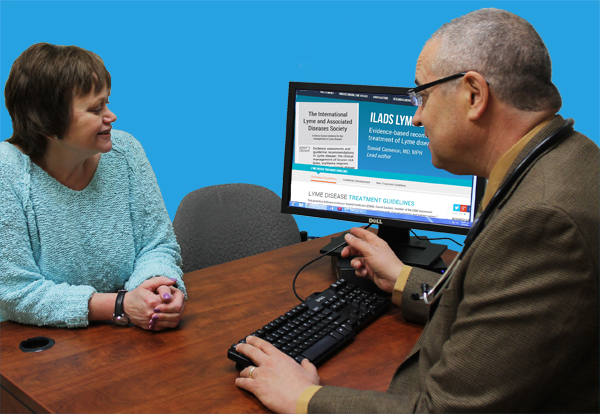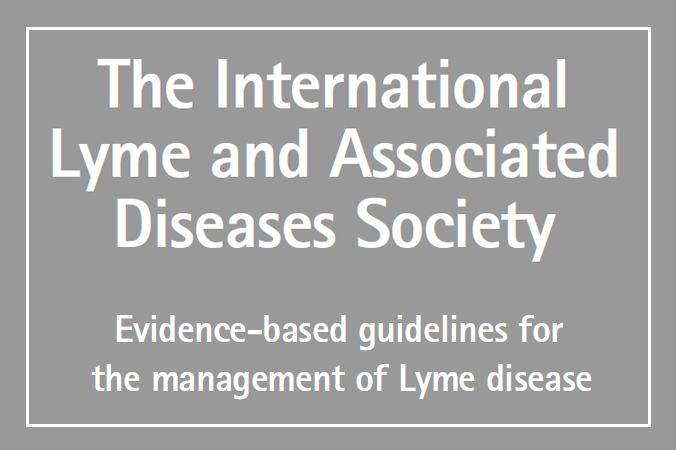2014 ILADS Lyme Disease Treatment Guidelines
- 2014 ILADS Treatment Guidelines
- References
2014 ILADS Treatment Guidelines
“We moved away from designating a fixed duration for antibiotic therapy and instead encourage clinicians to tailor therapy based on the patient’s response to treatment.” ─ Dr. Daniel Cameron
Lead author, 2014 ILADS Treatment Guidelines
The 2014 evidence-based guidelines provide clinicians with treatment recommendations, specifically for patients who fall into 3 categories ─ those with known tick bites, erythema migrans (EM) rashes and/or individuals with persistent symptoms.
Evidence assessments and guideline recommendations in Lyme disease: the clinical management of known tick bites, erythema migrans rashes and persistent disease.
Authors: Cameron DJ, Johnson LB, Maloney EL

The 2014 ILADS evidence-based guidelines provide clinicians with treatment recommendations for Lyme disease.
The guidelines adopted the Grading of Recommendations Assessment, Development, and Evaluation system (GRADE) as its basis for evidence assessment and the development of recommendations to ensure a transparent and trustworthy guideline process. [1-4] In the GRADE system, recommendations took into account not only the quality of the evidence, but also the balance between benefits and harms and patient values and preferences. [4]
The authors’ placed a high value on a practitioner’s ability to exercise clinical judgment in the absence of strong and compelling evidence to the contrary. [5] Additionally, they placed a high value on reducing patient risks for developing the chronic form of the disease and on reducing the serious morbidity associated with these disease forms. The authors’ values aligned with the Institute of Medicine’s goal of reducing the impact of chronic illness at the individual and national levels by, among other things, treating the treatable. [6]
The guidelines incorporated a patient-centered care focus on achieving treatment outcomes that patients value, [7] including the restoration of health, prevention of health deterioration, and the provision of treatments that have the potential to improve quality of life. To facilitate the development of treatment plans addressing the unique circumstances and values of individual patients, the patient-centered care approach shared medical decision-making.
ILADS Recommendations Summary
Management of patients with Ixodes species bites
- Recommends against single 200 mg dose of doxycycline.
- Recommends prompt prophylaxis with doxycycline 100 -200 mg twice daily for a minimum of 20 days for all Ixodes tick bites in which there is evidence of tick feeding, regardless of the degree of tick engorgement or the infection rate in the local tick population.
- Recommends patient education on prevention of future tick bites, on the manifestations of Lyme and other Ixodes-borne diseases and the manifestations and prevention of antibiotic-associated C. difficile infections.
Management of patients with Erythema Migrans (EM) rashes
- Recommends against treatment regimens using 20 or fewer days of phenoxymethylpenicillin, amoxicillin, cefuroxime or doxycycline and 10 or fewer days of azithromycin.
- Recommends a minimum of 4 – 6 weeks of amoxicillin, cefuroxime or doxycycline or a minimum of 3 weeks of azithromycin.
- Recommends ongoing assessments to detect persistence, progression or relapse of Lyme disease or the presence of other tick-borne illnesses. The initial assessment follows the completion of therapy; subsequent evaluations are done on an as-needed basis.
- Recommends extending treatment in patients who remain symptomatic after initial therapy.
- Recommends retreatment of persistent, recurrent or newly developed manifestations of Lyme disease.
- Recommends patient education regarding potential manifestations of Lyme disease and other Ixodes-transmitted infections, as well as the manifestations and prevention of antibiotic-associated C. difficile infections.
Management of patients with persistent post-treatment manifestations
- Strongly recommends discussing the possibility of antibiotic retreatment with all patients and performing individualized risk-benefit assessments for patient-appropriate options. Information on reducing the risk of antibiotic-associated C. difficile infections should be included in these discussions.
- Recommends 4 – 6 weeks of antibiotics when retreatment is undertaken, with antibiotic selection based on several factors.
- Recommends reassessment immediately following the initial course of retreatment and basing decisions regarding the subsequent modification or discontinuation of treatment on several factors.
If the initial course of antibiotic retreatment does not produce a complete response, clinicians should consider various options. Patients who had an incomplete response with one agent may be responsive to another; thus, switching agents may prove successful. Alternatively, combination therapy may be appropriate in select patients. Examples include those with known or suspected co-infections and patients who had incomplete responses to single agent therapy.
The guidelines are available in open access in the August 2014 edition of Expert Review of Anti-infective Therapy. Click on the button below to view.
References
References – 2014 ILADS Treatment Guidelines
- Guyatt G, Gutterman D, Baumann MH et al. Grading strength of recommendations and quality of evidence in clinical guidelines: report from an american college of chest physicians task force. Chest, 129(1), 174-181 (2006).
- Atkins D, Best D, Briss PA et al. Grading quality of evidence and strength of recommendations. BMJ, 328(7454), 1490 (2004).
- Schunemann HJ, Best D, Vist G, Oxman AD. Letters, numbers, symbols and words: how to communicate grades of evidence and recommendations. Cmaj, 169(7), 677-680 (2003).
- Guyatt GH, Oxman AD, Vist GE et al. GRADE: an emerging consensus on rating quality of evidence and strength of recommendations. BMJ, 336(7650), 924-926 (2008).
- Classifying recommendations for clinical practice guidelines. Pediatrics, 114(3), 874-877 (2004).
- Living Well with Chronic Illness: A Call for Public Health Action, Available from https://www.iom.edu/Reports/2012/Living-Well-with-Chronic-Illness.aspx
- Institute of Medicine (Committee on Quality of Health Care in America). Crossing the Quality Chasm: A New Health System for the 21st Century. (National Academies Press, Washington, DC, 2001) 360.

Benefits of Lyme Research
Through LDPR, patients gain access to clinical trials by the same doctors who are treating them, and they are often among the first to receive new, proven therapies for their disease. more

Treatment Guidelines
Practice treatment guidelines should summarize the best evidence. Unfortunately, the 2000 and 2006 Infectious Diseases (IDSA) Guidelines did not reflect the EBM that our practice follows. more

2004 Treatment Guidelines
Practice treatment guidelines serve as a guide for doctors for the appropriate treatment. Using the best available evidence, the International Lyme and Associated Diseases Society (ILADS) expert panel identified and developed practice recommendations for Lyme disease in 2004 more



